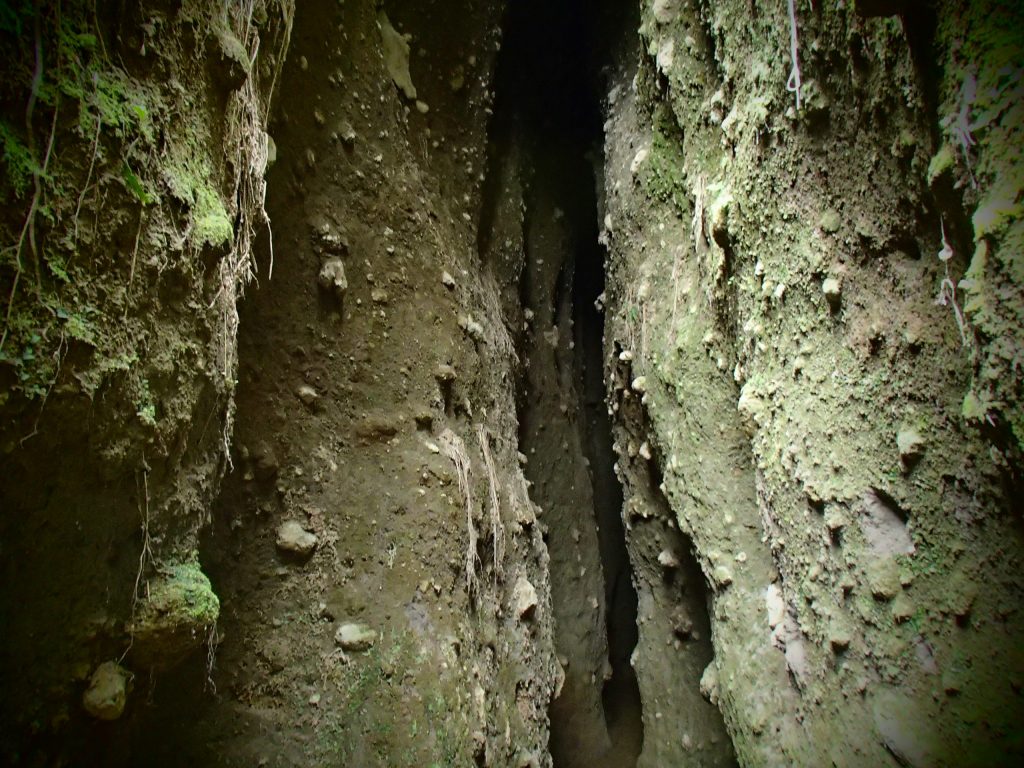Tonkararin
If you love a good mystery – or dark, narrow spaces! – , then you are bound to be intrigued by Tonkararin. The many questions surrounding Tonkararin serve to make the site more interesting and you cannot help but come up with your own theories as you explore.
Tonkararin is so mysterious it’s hard to know how to begin to describe it so I will let the Nagomi Town tourist board where Tonkararin is do their best:
This is a tunnel shaped ancient remain built on a slope connected to Etafunayama Kofun (ancient tomb). This 445.1 meter long remain consists of a closed conduit and cracks. It still remains unknown when it was built, by whom and for what purpose. Nagomi Trip
Unfortunately, this brief description does not really do it justice, apart from outlining that no one knows what it is, who built it, why they built it or even when they built it. My local guide was not much more forthcoming, laughingly answering most of my questions with a wry ‘Wakaranai’ – ‘ I don’t know’.
However, my guide did let me know some background about Tonkararin and a couple of theories that have been offered which I’d like to share.
After its discovery, Tonkararin’s name became known all over Japan , when a famous Japanese novelist, and ancient history buff, suggested that the site might be connected to the ancient kingdom of Yamataikoku. (According to Chinese records Yamataikoku is the name of a country within Japan ruled by a powerful Queen named Himiko around 2000 years ago. Similar to King Arthur’s court the exact location of Yamataikoku is still unknown though many people believe it was in northern Kyushu).
Archaologists in the 1970’s originally speculated that the Tonkararin system of tunnels and natural fissures was an ancient water course dating back to the time of the Kofun tombs (5th or 6th C AD) . However, in more recent years that theory has lost favour and several archaologists now suggest the tunnel system had a religious use, hypothesising some kind of Shamanistic ritual to do with re-birth. The site has yet to have an in depth archaological investigation and frustratingly there are no local myths or folklore associated with the site to act as clues.
There may be hints in the name however. If you know some Japanese you will realise that Tonkararin has no meaning, the name is written, not in kanji but in in katakana, a writing system used for foreign words or onomatapoeiac words. So its not surprising that there are two explanations for the name; the onomatapoeic one is that ‘Tonkararin’ is the sound if you drop a rock down into the deep fissure from the top of the tunnel. However, my guide assured me that in reality the sound would be ‘To daaann’ – I think he may have tried!
The second is that Tonkararin is not Japanese at all but comes from a Korean word ‘Tongurami’ (if any Korean speakers can tell me what Tongurami means I would love to know as Google translate has never heard of it!) Ancient burial tombs in the area contain many artifacts very similar to ancient Korean artifacts and there is no doubt that people from the southern Korean peninsula and Japan traded and moved between countries in ancient times, so there may well be some connection…. or it may just be another case of ‘Wakaranai’.
How to get there
If you would like to visit, the good news is the site is free. It’s situated in the village of Eda in northern Kumamoto. There are only signs in Japanese, so look for トンカラリン.The road to Tonkararin is directly across from the entrance road to Higo Minkan Mura 肥後民間村 in Nagomi on route 16 (also signed in Japanese). Follow the road for a couple of minutes into the village and when you see a large white signboard (see photo gallery ) you are there. You can park on the grassy area behind the sign board. Follow a small footpath behind the house on your left and you will come to the start.
Travel Tips
Warning! Don’t enter the tunnels unless you have a torch and clothes you don’t mind getting dirty, a hat and gloves are recommended too. The best time to go is in the cooler months because you are less likely to meet snakes or insects and the path is not overgrown.
The first tunnel you come to is only accessible for foolhardy adults or small, brave children, there are 7 stairs up to it and its about 30 m long – my advice is to take a look inside and then skip it by walking over the top until you come to the tunnel exit then you can descend into an open grassy pathway which leads into the first natural fissure, this is dark and narrow but fun to squeeze through, watch your step as the path rises and there may be some water puddles to navigate. Exiting the first fissure the path deepens and you will soon face the deepest fissure, which is 40 m long and covered with stones at the top, pitch black and joins on to a manmade stone tunnel of 30 m in length. Again there is a climb up to this and the tunnel itself is pretty narrow with no room to turn around once you enter. We explored as far as the beginning of the manmade tunnel then headed back through the fissure and made our way over the top of the fissure to the far end of the manmade tunnel to have a look inside.
Continue up the path from the end of the tunnel and you will come to the village shrine which has a couple of unusual cow statues and some beautiful animal carvings on the main shrine building. You can then either go back down through the fissures or take the road down hill back to the parking area.
If you’d like to visit Tonkararin with a guide contact Explore Kumamoto for details. It can be combined with a visit to the samurai swordsmith in Arao, a visit to Yamaga to see the Yachiyoza Theatre or to see some of the ancient kofun burial tombs in the area.
[codepeople-post-map]
〒865-0135, 3481 瀬川 和水町 玉名郡 熊本県

